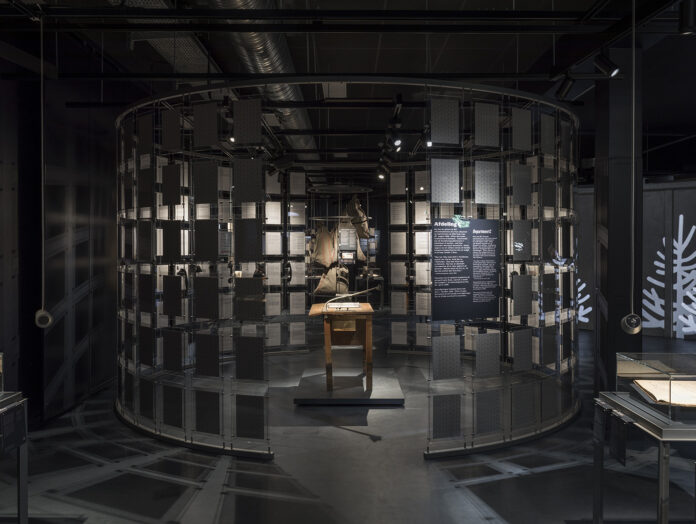On February 25th, the “ENIGMA – Museum for post, tele og kommunikation” in Copenhagen, Denmark, opened its doors to the public. The exhibition, which was designed by ATELIER BRÜCKNER, takes visitors on a journey through the history of communication, connecting it to the present and inspiring contemplation of the future. The museum encourages exploration, exchange, and reflection among its visitors, with the aim of redefining the role of traditional cultural institutions in a society that has entered the digital age.
The exhibition “Communication in Crisis” is housed in the museum, which is located in a former post office. It showcases how communication technology develops rapidly during times of crisis. The exhibition is presented in a dynamically activated environment with dim lighting, while the “Ideas that Connect Us” exhibition is located in bright, well-lit spaces that offer an archival journey through communication and media history. The exhibition features a continuous library of historical artifacts, as well as hands-on and digital interactive exhibits.
A grid structure along the ceiling connects the exhibition themes and expands across the spaces, providing an infrastructure for exchangeable exhibition elements such as hanging interpretive panels, filmic storytelling, and audio installations. The exhibit floor system is designed to be flexible and incorporate updatable objects, artifacts, and haptic and digital interactions. A modular labeling system complements the scenographic setup and allows for interchangeability and regular content updates.
The museum chronicles the history of communication from the establishment of the Danish postal service in 1624 to the present day, including the use of SpaceX’s Starlink satellites to provide internet to Ukrainians during wartime. The “Communication in Crisis” exhibition expands on historical eyewitness stories and grand narratives, offering alternative approaches for the present era of mass communication and the future.
One of the museum’s key objects is an Enigma machine, which is displayed in an immersive setup within the “Strictly Confidential” thematic area. Other themes include “Someone’s Watching Us,” which highlights the historical Danish national surveillance organization, Department C; “In the Event of War,” which exhibits the emergency and safety practices and protocols of the Danish government during wartime; and “Alternative Truths,” which tackles issues related to governmental transparency in news and information distribution, culminating in the artistic documentary “In the Event of Moon Disaster.”

The themes are brought to life through scenographically staged spaces, such as a reconstructed bunker, and are accompanied by “Empowerment Kiosks” where visitors can interact and provide input on current thematic issues, such as how long it takes a hacker to decrypt a personal password that has just been entered.
Spatially, the themes are arranged around a central forum installation where visitors actively take part in a communication debate connected to a collective digital cloud. Visitors are asked questions such as how often they back up their computers and whether they are prepared for a crisis. The visitors contribute their own reflections on these specific topics, and the responses are gathered and displayed by an LED ring as an abstract color-based morphic infographic, with its light spreading throughout the space.
The “Ideas that Connect Us” exhibition is housed in an adjoining building with ample daylight. It features modular shelving that surrounds the rooms, with objects arranged chronologically within themes such as Postal, Telegraphy, The Telephone, Wireless, Radio, Television, The Mobile Phone, and The Internet. QR codes provide additional information on demand, while interactive installations invite visitors to investigate the former technologies.
Large workshop tables are situated at the center of the rooms and can be booked for school classes, transforming the space into a laboratory. By tinkering with technology, visitors can gain a better understanding of it, including technology that others have created for them. As the tools used to communicate have changed over time, visitors to the museum are invited to take part in shaping the future of communication. After all, every technology started as an idea – an idea to change the world.
Discover more from SNAP TASTE
Subscribe to get the latest posts sent to your email.




Aw, this was a very good post. Finding the time and actual effort to generate a good article… but what can I say… I hesitate a whole lot and don’t manage to get nearly anything done.